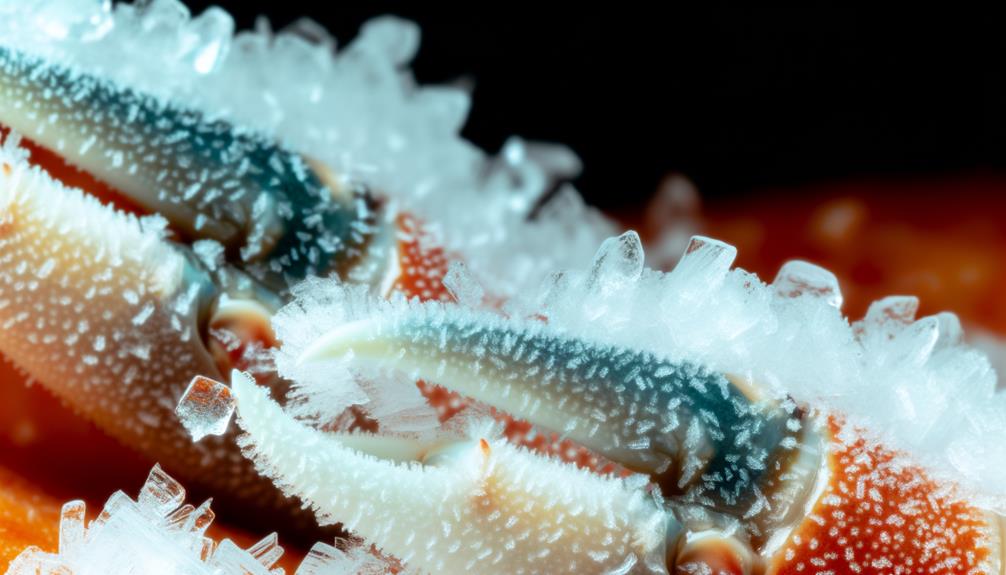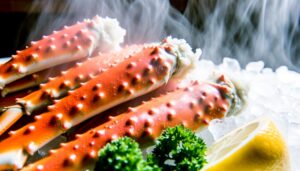Are Frozen Snow Crab Legs Already Cooked?
Yes, frozen snow crab legs are already pre-cooked. They're harvested, sorted, cleaned, and cooked onboard the fishing vessels to retain their premium quality.
After cooking, they undergo flash freezing which preserves their texture and flavor by preventing ice crystal formation. This process guarantees that snow crab legs maintain their sweet, delicate taste and firm, succulent texture.
All you need to do is reheat them, using methods like steaming, boiling, or baking. Understanding the intricacies of these processes will enhance your culinary experience and make sure you enjoy snow crab legs at their best.

Key Takeaways
- Frozen snow crab legs are pre-cooked and only need reheating.
- They are cooked onboard immediately after capture.
- Flash freezing preserves their taste and texture.
- Vacuum-sealed packaging maintains freshness and prevents contamination.
- Reheating methods include steaming, boiling, baking, or microwaving.
Frozen Snow Crab Basics
Understanding the basics of frozen snow crab involves recognizing that these crustaceans are usually pre-cooked and flash-frozen immediately after harvesting to preserve their quality and flavor.
This process ensures that you get a product with excellent taste and texture. When you purchase frozen snow crab, you're basically getting a ready-to-eat item that only requires reheating.
The rapid freezing locks in the moisture and prevents the formation of ice crystals, which can damage the meat. Additionally, pre-cooking the crab reduces the risk of bacterial contamination, making it safer for consumption.
When you thaw and reheat the crab, you'll notice that its flesh remains firm and succulent, retaining the subtle sweetness characteristic of fresh snow crab.
Harvesting Snow Crab
When it comes to harvesting snow crab, sustainable fishing practices are crucial to maintaining healthy populations. The timing of the harvesting season is meticulously regulated to guarantee crabs are caught at their peak and to prevent overfishing.
Additionally, strict regulations on crab size are enforced to allow younger crabs to mature and reproduce, safeguarding the long-term viability of the species.
Sustainable Fishing Practices
Embracing sustainable fishing practices for harvesting snow crab guarantees the long-term health of marine ecosystems and the viability of crab populations.
You'll need to understand that these methods involve strict adherence to quotas, size limits, and gear restrictions. Bycatch reduction techniques, such as escape panels in traps, guarantee minimal impact on non-target species.
Monitoring and reporting systems, including satellite tracking and observer programs, help you verify compliance and manage stocks effectively.
Habitat conservation measures, like protecting spawning grounds and restricting bottom trawling, preserve essential ecosystems.
Harvesting Season Timing
The timing of the snow crab harvesting season is carefully regulated to align with the species' life cycle and guarantee peak population recovery. You'll find that these regulations consider molting periods, mating cycles, and larval release to prevent overfishing.
Harvesting typically occurs between late fall and early spring, coinciding with colder water temperatures that reduce the crabs' metabolic rate, making them less active and easier to capture. Fisheries management agencies set specific quotas and timeframes to maintain ecological balance and sustainability.
Crab Size Regulations
Snow crab fisheries follow strict size regulations to guarantee that only mature crabs are harvested, thereby supporting population sustainability and ecological balance.
When you're involved in harvesting, you'll need to follow these guidelines:
- Minimum Carapace Width: Crabs must meet a minimum carapace width, often around 95mm, to confirm they're mature enough to have reproduced.
- Sex-Based Restrictions: Only male crabs are typically harvested, as female crabs play a crucial role in maintaining population levels.
- Bycatch Limitations: Fisheries must minimize bycatch, which includes non-target species and undersized crabs, to lessen ecological impact.
- Seasonal Quotas: There are caps on the number of crabs that can be harvested each season, ensuring long-term sustainability of crab populations.
These regulations are essential for preserving a balanced marine ecosystem.
Processing Methods
When you're dealing with frozen snow crab legs, it's important to understand the harvesting and freezing techniques used to guarantee best quality. These methods not only capture the crabs at their peak freshness but also employ advanced technologies to preserve their nutritional content.
Harvesting and Freezing Techniques
Proficiency in harvesting and freezing methods is essential to ensure the snow crab legs you savor maintain their finest flavor and texture. The process starts with catching the crabs at the peak of their season, ensuring ideal meat quality. Immediate processing on the vessel is pivotal to lock in freshness.
Here are the key steps:
- Harvesting: Crabs are caught using specialized traps to minimize damage and stress.
- Onboard Processing: Crabs are sorted, cleaned, and cooked right on the ship to preserve natural flavors.
- Flash Freezing: Cooked crab legs are flash-frozen at extremely low temperatures to maintain texture and moisture.
- Packaging: Vacuum-sealed packaging protects the crab legs from freezer burn and contamination, ensuring they reach you in prime condition.
Nutritional Preservation Methods
To secure that the nutritional value of snow crab legs is preserved from sea to table, advanced processing methods like flash freezing and vacuum sealing are employed. Flash freezing rapidly reduces the temperature of the crab legs, preventing the formation of large ice crystals that can damage cellular structures and degrade nutritional quality.
Vacuum sealing removes air from the packaging, minimizing oxidation and the risk of freezer burn, thereby maintaining the integrity of essential nutrients like omega-3 fatty acids, proteins, and vitamins. These techniques safeguard that when you thaw and cook your snow crab legs, they retain their fresh-caught taste and nutritional benefits.
Understanding these methods allows you to appreciate the quality and care involved in delivering premium seafood.
Cooking at Sea
Fishing vessels often cook snow crab legs immediately after the catch to preserve freshness and guarantee ideal flavor. This onboard cooking process involves several critical steps to maintain quality. You'll find these vessels equipped with industrial-grade boilers and steamers specifically designed for high-volume seafood processing.
Here's a breakdown of the key steps:
- Immediate Processing: Crabs are cooked within hours of capture, minimizing degradation.
- Controlled Temperatures: Boilers maintain precise temperatures to avoid overcooking, which can compromise texture.
- Sanitation Protocols: Rigorous cleanliness standards prevent contamination, safeguarding safety and quality.
- Rapid Cooling: Once cooked, crab legs are swiftly cooled to lock in flavor and texture.
Freezing Techniques
When it comes to preserving the quality of snow crab legs, flash freezing is essential.
You'll find that this technique rapidly lowers the temperature, preventing ice crystals from forming and thereby maintaining texture and flavor.
Additionally, specific nutrient preservation methods guarantee that the crab retains its crucial vitamins and minerals throughout the freezing process.
Flash Freezing Process
Flash freezing is a method that rapidly lowers the temperature of snow crab legs to preserve their freshness and texture, ensuring they maintain their quality from sea to table. This process involves exposing the crab legs to extremely low temperatures, often using liquid nitrogen or specialized blast freezers. By doing so, you prevent the formation of large ice crystals, which can damage the cellular structure and degrade the meat's quality.
Consider the advantages of flash freezing:
- Rapid Temperature Reduction: Secures minimal ice crystal formation.
- Extended Shelf Life: Keeps crab legs in prime condition for longer periods.
- Maintained Freshness: Locks in the natural flavors and texture.
- Nutrient Retention: Preserves the essential vitamins and minerals.
Understanding flash freezing helps you appreciate the superior quality of pre-frozen snow crab legs.
Nutrient Preservation Methods
Building upon the advantages of flash freezing, various nutrient preservation methods ensure that snow crab legs retain their best nutritional profile and culinary quality. Cryogenic freezing utilizes liquid nitrogen at extremely low temperatures to rapidly freeze the crab legs, minimizing ice crystal formation that can damage cellular structure.
IQF (Individually Quick Freezing) focuses on freezing each piece individually, ensuring that the snow crab legs don't clump together and retain their texture and taste. These advanced techniques not only lock in essential vitamins and minerals but also preserve the delicate, succulent flavor.
Packaging Process
The packaging process for frozen snow crab legs involves meticulous steps to safeguard both quality and safety are maintained. First, the crabs are flash-frozen immediately after being caught to lock in freshness and nutritional value.
Second, they undergo a thorough inspection for any signs of damage or imperfections.
Third, the crab legs are vacuum-sealed in airtight, food-grade packaging to prevent freezer burn and contamination.
Finally, they're labeled with essential information including the harvesting date, processing details, and storage instructions.
These steps safeguard:
- Optimal freshness is preserved.
- Integrity of the product is maintained.
- Safety standards are strictly adhered to.
- Transparency for consumers regarding the product's origin and handling.
Understanding this process helps you appreciate the care taken to deliver high-quality frozen snow crab legs.
Identifying Pre-Cooked Crab
One reliable method to identify pre-cooked snow crab legs is by examining their shell color; pre-cooked crab legs typically exhibit a bright orange or red hue, in contrast to the greenish-brown color of raw crab legs.
Additionally, the texture of pre-cooked crab meat is firm and slightly opaque, while raw crab meat is translucent and gelatinous.
Pay attention to the packaging labels as well; terms like 'pre-cooked,' 'ready-to-eat,' or 'fully cooked' are clear indicators.
When you handle the crab legs, pre-cooked ones often have a more resilient and less flexible shell due to the cooking process.
These characteristics will help you confidently determine if the snow crab legs are pre-cooked.
Reheating Instructions
To reheat pre-cooked snow crab legs effectively, utilize methods such as steaming, boiling, or baking to maintain their delicate texture and enhance flavor. Each technique has specific steps to achieve the best results:
- Steaming: Place crab legs in a steamer basket over boiling water. Cover and steam for 5-7 minutes.
- Boiling: Submerge crab legs in a large pot of boiling water with added salt. Boil for 3-5 minutes.
- Baking: Preheat your oven to 350°F, wrap crab legs in aluminum foil, and bake for 10-15 minutes.
- Microwaving: Wrap crab legs in damp paper towels, place in a microwave-safe dish, and heat on high for 2-3 minutes.
These methods ensure effective reheating without compromising the snow crabs' quality.
Flavor and Texture
Understanding the flavor and texture of pre-cooked snow crab legs is important for securing an ideal culinary experience. Pre-cooked snow crab legs exhibit a sweet, delicate taste profile that's enhanced by their natural brininess. This flavor is best preserved through gentle reheating methods such as steaming or boiling.
The texture should be firm but tender, offering a satisfying bite without being rubbery or mushy. Overcooking can compromise this delicate balance, leading to a tough, chewy texture that detracts from the overall enjoyment. When you reheat, aim for a uniform warmth that maintains the crab's inherent juiciness.
Nutritional Benefits
Packed with necessary vitamins and minerals, snow crab legs offer a strong nutritional profile that supports overall health and well-being. When you incorporate snow crab legs into your diet, you're providing your body with a rich source of high-quality protein, omega-3 fatty acids, and several key micronutrients. Here's a closer look at some of the nutritional benefits:
- Protein: Snow crab legs are an excellent source of lean protein, promoting muscle repair and growth.
- Omega-3 Fatty Acids: These essential fats support cardiovascular health and reduce inflammation.
- Vitamin B12: Essential for nerve function and red blood cell formation, enhancing overall vitality.
- Zinc: Important for immune function, wound healing, and DNA synthesis.
Storage Tips
Maintaining the nutritional integrity of snow crab legs requires proper storage techniques to prevent spoilage and preserve their rich flavor and texture.
First, keep the crab legs in their original packaging or transfer them to an airtight container to minimize exposure to air and moisture. Store them in the coldest part of your freezer, ideally at -18°C (0°F) or lower, to inhibit bacterial growth and enzymatic activity.
If you need to thaw them, place them in the refrigerator for 24 hours, ensuring a gradual temperature change that maintains their quality. Avoid refreezing once thawed, as this can degrade texture and flavor.
Serving Suggestions
For a gourmet dining experience, serve your snow crab legs with clarified butter, a squeeze of fresh lemon, and a sprinkle of sea salt. These simple yet sophisticated accompaniments enhance the delicate, sweet flavor of the crab meat.
To elevate your presentation, consider the following serving suggestions:
- Garnish with Fresh Herbs: Dill, parsley, or chives add a burst of color and aromatic complexity.
- Pair with White Wine: A crisp Sauvignon Blanc or Chardonnay complements the richness of the crab.
- Create a Dipping Sauce: Blend mayonnaise with sriracha or Old Bay seasoning for a spicy kick.
- Serve with a Side: Steamed asparagus or a light salad balances the dish with freshness and texture.
These elements guarantee a well-rounded, exquisite meal.
Conclusion
In sum, frozen snow crab legs are culinary marvels, already cooked to perfection at sea before being flash-frozen. This guarantees you experience an unparalleled burst of oceanic flavor and impeccable texture, akin to dining at a five-star seafood restaurant.
With their rich nutritional profile and convenience, they're nothing short of a gastronomic masterpiece. Store them properly, and you'll always have a gourmet seafood feast at your fingertips.
Immerse yourself; your taste buds will thank you profusely!






